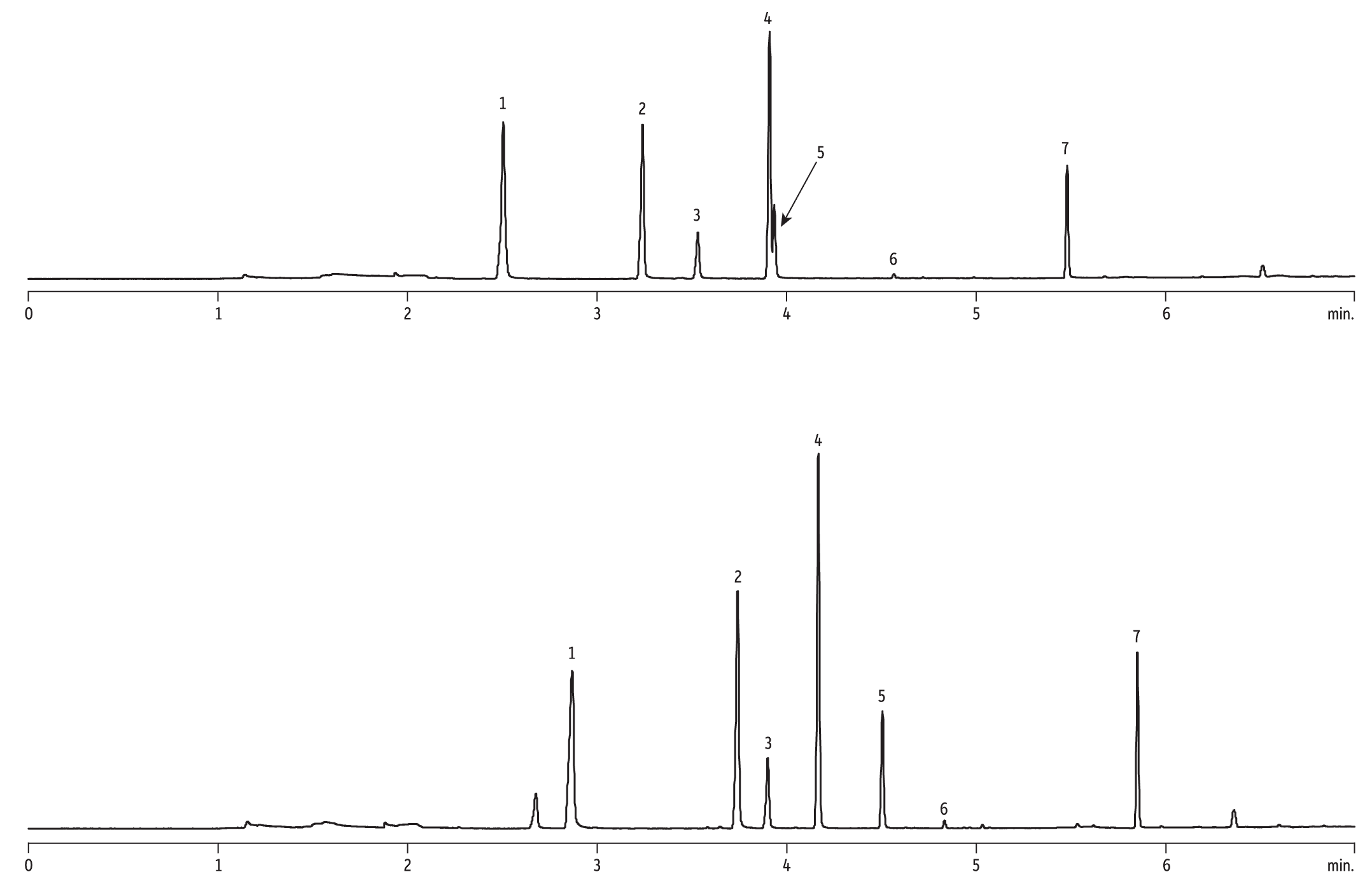Method 504.1: EDB, DBCP, and 123TCP Analysis in Water by Microextraction and GC
Separate 1,2-Dibromoethane (EDB), 1,2-Dibromo-3-Chloropropane (DBCP), and 1,2,3-Trichloropropane (123TCP)
EPA Method 504.1 is a common test performed by environmental laboratories for the analysis of 1,2-dibromoethane (EDB), 1,2-dibromo-3-chloropropane (DBCP), and 1,2,3-trichloropropane (TCP) in drinking water. This method uses parallel dual-column gas chromatography with electron capture detection (GC-ECD), the same instrument setup that is used for the analysis of chlorinated pesticides and herbicides. Thus, when selecting a set of capillary columns for EDB, DBCP, TCP analysis, it is advantageous that they work well for a number of different methods.
The Rtx-CLPesticides and the Rtx-CLPesticides2 columns provide excellent separation for the compounds listed in Method 504.1, as well as for analytes in several other drinking water methods. The chromatograms below show the analysis of the Method 504.1 target compounds on these columns connected in parallel using a glass ‘Y’ Press-Tight connector. This configuration is important to ensure that both the primary and confirmation column analyses are performed simultaneously under the same conditions and using the same injection port. Method 504.1 requires that EDB, DBCP, and TCP be fully resolved from the common interference compounds (e.g., chloroform, bromodichloromethane, chlorodibromomethane, 1,1,1,2-tetrachloroethane, and bromoform). The Rtx-CLPesticides2 columns fully resolved these compounds. Note that the coelution of 1,1,1,2-tetrachloroethane and bromoform is between two interference compounds; it does not affect the identification or quantification of EDB, DBCP, or TCP.
| Vendor | Column Pair | Analysis Time (min) | Coelutions | Restek Advantage |
|---|---|---|---|---|
| Restek | Rtx-CLPesticides / Rtx-CLPesticides2 |
6 / 6 | 0 / 0 |
|
| Competitor A | column 1 / column 2 | 6 / 6 | 0 / 0 | |
| Competitor B | column 1 / column 2 | NDP | NDP |
Comparison based on published competitor data. All columns tested were 0.32 mm ID. NDP=no data published
EDB, DBCP, and TCP analysis on Rtx-CLPesticides and Rtx-CLPesticides2 columns according to EPA Method 504.1

| Peaks | CLP1 tR (min) | CLP2 tR (min) | |
|---|---|---|---|
| 1. | Bromodichloromethane | 2.504 | 2.866 |
| 2. | Chlorodibromomethane | 3.239 | 3.740 |
| 3. | 1,2-Dibromoethane (EDB) | 3.531 | 3.899 |
| 4. | 1,1,1,2-Tetrachloroethane | 3.910 | 4.166 |
| 5. | Bromoform | 3.935 | 4.505 |
| 6. | 1,2,3-Trichloropropane (TCP) | 4.655 | 4.833 |
| 7. | 1,2-Dibromo-3-chloropropane (DBCP) | 5.480 | 5.850 |
| Columns | Rtx-CLPesticides2 30 m, 0.32 mm ID, 0.25 µm (cat.# 11324) |
|---|---|
| and Rtx-CLPesticides 30 m, 0.32 mm ID, 0.32 µm (cat.# 11141) | |
| using Rxi guard column 5 m, 0.32 mm ID (cat.# 10039) | |
| with universal “Y” Press-Tight connector (cat.# 20405) | |
| Standard/Sample | Dibromochloromethane (chlorodibromochloromethane) (cat.# 30271) |
| Bromodichloromethane (cat.# 30251) | |
| 504.1 calibration mix (cat.# 30239) | |
| 1,1,1,2-tetrachloroethane (cat.# 30411) | |
| Bromoform (cat.# 30252) | |
| Diluent: | n-Hexane |
| Conc.: | 10 ng/mL |
| Injection | |
| Inj. Vol.: | 2 µL splitless (hold 0.50 min) |
| Liner: | Premium 4 mm single taper inlet liner w/wool (cat.# 23303) |
| Inj. Temp.: | 200 °C |
| Purge Flow: | 50 mL/min |
| Oven | |
| Oven Temp.: | 30 °C (hold 2.0 min) to 220 °C at 30 °C/min |
| Carrier Gas | He, constant flow |
| Linear Velocity: | 60 cm/sec |
| Detector | Micro-ECD @ 220 °C |
|---|---|
| Make-up Gas Flow Rate: | 50 mL/min |
| Make-up Gas Type: | He |
| Data Rate: | 50 Hz |
| Instrument | Agilent/HP6890 GC |
| Notes | This chromatogram was obtained using an Agilent micro-ECD. To obtain comparable results, you will need to employ a micro-ECD in addition to confirmational dual-columns connected to a 5-meter guard column using a “Y” Press-Tight connector. |

